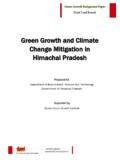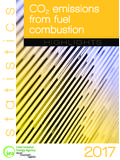Transcription of Mitigation of Development Air Quality Impacts - IAQM
1 IAQM u Position Statement Mitigation of Development Air Quality Impacts Mitigation of Development Air Quality Impacts June 2018 | Version The IAQM issues Position Statements on matters that could affect the way in which Members carry out their professional tasks and on air Quality topics and issues where the IAQM can provide a unique perspective from which to give a professional opinion. The issue Members are able to predict the pollution The National Planning Policy Framework gives no specific detail concentrations from/at individual new developments on air Quality Mitigation for general Development purposes with an acceptable degree of precision in their Air Quality (only for minerals Development under para 144). The national Assessments. Members compare these numbers with AQS Planning Practice Guidance does provide some high-level objectives or limit values to inform their professional judgement general advice, noting that Mitigation should be proportionate on the Impacts .
2 In those situations where a significant adverse to the likely impact (suggesting a cost-benefit balance) and impact is predicted, Mitigation usually needs to be applied. listing some examples of Mitigation ; however, it provides no As one example, if exposure of new occupants to NO2 at a guidance on how the most appropriate Mitigation option(s). representative receptor within the new Development is forecast should be chosen for a given application, or on the efficacy of to be 45 g m-3, then the aim should be to reduce the level to the different Mitigation options. below the 40 g m-3 objective. The IAQM position on this issue For point sources, we often have good evidence/data on the The IAQM position is that the appropriate Mitigation solution abatement efficiency of proposed emissions controls, allowing for the operational air Quality impact of any given individual us to be reasonably certain in our prediction of the residual general Development scheme should be principle-led rather impact after implementation of the Mitigation for the individual than specified by detailed prescription.
3 Development . However, for non-point sources of pollution there is much less quantitative evidence on the efficacy of The IAQM recommends that the following basic hierarchy the various Mitigation options available. This makes it more principles (drawn from similar well-established Mitigation difficult to confidently recommend a Mitigation solution for hierarchies used for EIA development1 and for dealing with a new Development that would, for example, reduce the 45 pollution exposure in workplace/occupational situations2,3). g m-3 by at least 5 g m-3 at the point of receptor exposure. be used as the basis for mitigating the operational air Quality Yet members must still arrive at a conclusion on the residual Impacts associated with general Development schemes. This impact in their Air Quality Assessment. hierarchy is suitable both for Impacts caused by a potentially polluting new Development , and for the impact of exposure This raises a number of questions for Members assessing of new occupants of a Development proposed in an area of the operational Impacts of individual general Development existing poor air Quality .
4 Schemes ( residential, commercial, retail, etc), where distributed sources such as road traffic are often the main issue: I. Preference should be given to preventing or How do we weigh up the likely efficacies of different avoiding exposure/ Impacts to the pollutant in Mitigation solutions in removing the excess impact , when the first place by eliminating or isolating potential there are few robust data sources available to allow a sources or by replacing sources or activities with comparison on a like-for-like basis? alternatives. This is usually best achieved through taking air Quality considerations into account at the Where there are several alternative Mitigation /control Development scheme design stage. options, how should we choose? II. Reduction and minimisation of exposure/ Impacts Should some Mitigation approaches be used in preference should next be considered, once all options for to others, or are all born equal?
5 Prevention/avoidance have been implemented so far as is reasonably practicable (both technically Should all possible Mitigation options be applied, or just and economically). To achieve this reduction/. a selection; and if the latter, on what basis do we choose minimisation, preference should be given first to: the right mix? a. Mitigation measures that act on the source; before b. Mitigation measures that act on the pathway;. What is and is not within the developer's power to influence? which in turn should take preference over c. Mitigation measures at or close to the point of And how far should a developer reasonably be expected receptor . to go? Position Statement Mitigation of Development Air Quality Impacts | January 2015 | | 1. IAQM u Position Statement Mitigation of Development Air Quality Impacts Mitigation of Development Air Quality Impacts .
6 All subject to the efficacy, cost and practicability of About the Institute of Air Quality Management (IAQM). the available solutions. In each case, measures that The IAQM aims to be the authoritative voice for air Quality by are designed or engineered to operate passively are maintaining, enhancing and promoting the highest standards preferred to active measures that require continual of working practices in the field and for the professional intervention, management or a change in people's Development of those who undertake this work. Membership behaviours. of the IAQM is mainly drawn from practising air Quality professionals working within the fields of air Quality science, III. Off-setting a new Development 's air Quality air Quality assessment and air Quality management. impact by proportionately contributing to air Quality improvements elsewhere (including those Copyright statement identified in air Quality action plans and low Copyright of these materials is held by the IAQM.)
7 We emission strategies) should only be considered once encourage the use of the materials but request that the solutions for preventing/avoiding, and then for acknowledgement of the source is explicitly stated. reducing/minimising, the Development -specific Impacts have been exhausted. Even then, offsetting Change Log should be limited to measures that are likely to - June 2018. have a beneficial impact on air Quality in the vicinity Clarification throughout that application is for indvidual of the Development site. It is not appropriate developments. to attempt to offset local air Quality Impacts by Insertion of additional final two sentences in Point III of the measures that may have some effect remote from table to highlight that offsetting benefits should apply to the the vicinity of the Development site. vicinity of the Development .
8 Within II (Reduction and minimisation), the efficacies and costs of the different Mitigation options should be taken into account; as more research and operational data become available on these, the use of this hierarchy as a selection tool can be expected to move from a mainly qualitative towards a more quantitative basis. References 1. Institute of Environmental Management & Assessment (IEMA), Guidelines for Environmental impact Assessment (2004). 2. The Management of Health and Safety at Work Regulations 1999, Regulation 4. 3. COSHH Regulation 7, Prevention or control of exposure to substances hazardous to health. Position Statement Mitigation of Development Air Quality Impacts | January 2015 | | 2.










